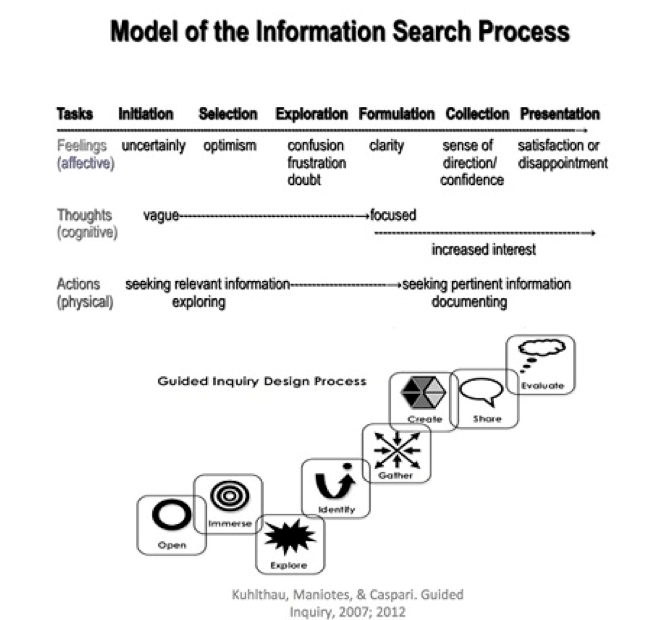(and Before and Beyond)

Reflecting on the need for an evidenced-based inquiry process to support 21st century inquiry, I have come to revisit Kuhlthau’s ISP and GID Framework once more. Currently, the TL programs running at my college include a variety of sessions all intended to enhance the learning outcomes of students while also supporting teachers. A monopoly of reading comprehension and writing sessions has been commonplace this year. While the value of this is unquestionable, the team has realised we also need to refocus to ensure all facets of our role are equally met; curriculum leader, information specialist, and information services manager. While these have not been entirely neglected, they have dipped out of the spotlight. Not only can we support the college in developing effective literacy practices and metalanguage surrounding this, we must also support the information needs of our clients through digital and information literacy programs.
This got me thinking about our recent lessons with Year 7 HPE students. The TL team held interactive lessons with all classes to develop their search and retrieval skills, as students are about to embark on several small research activities throughout the term. These lessons were buzzing with student and teacher engagement. Students learnt, first-hand, the power of key words and Boolean phrases. Now, as I think back to Kuhlthau’s Information Search Process [ISP], I see it would be highly beneficial to revisit each class while they’re in the exploration stage and perhaps feeling the sudden and stabbing pangs of uncertainty and research anxiety (Kuhlthau, 2004). I experienced this myself during my last assignment for this semester. I had never felt such anxiety or uncertainty around a topic and my thinking. I was overwhelmed with the information and could not see a way out. I was in the dip and it was quickly becoming an abyss. With a moment of clarity, I sought intervention. The information barrier had led to a total cognitive and affective meltdown but, with intervention, I regained my certainty and refocused my thinking (Kuhlthau & Cole, 2013). If that is not ISP in action I don’t know what is. If this was my extreme, how are the Year 7s currently coping with only infantile inquiry capabilities?

Well, the Year 7 HPE students are approaching the danger zone (Kuhlthau & Cole, 2013). So, how can I, as a TL, support them? Kuhlthau and Cole (2013) suggest tapping into the Third Space. It is now, in this space of uncertainty, that students need reminding to tap into their prior knowledge. As a true constructivist approach, GID reminds students to build on and reflect on their knowledge and belief systems. We must revisit the search process, collaborate and share findings and thinking, relate the new information to old, and engage with the wider community to expand understanding and connect the new information to the world. Students must first be encouraged to relax, slow down, read without distraction and reflect on the information (Kuhlthau, Maniotes, & Caspari, 2012). There are many stages of intervention throughout the ISP; however, the dip requires particular attention because it could make or break knowledge construction and task engagement. A series of reflective questions helps at this stage. Kuhlthau, Maniotes and Caspari (2012) recommend asking students what they have found interesting thus far, what they’d like to share with others, and what questions they have. Engaging with others provides students with an opportunity to further tap into the Third Space, to connect the academic world to their world. The Third Space allows students to connect to their world to construct new ideas and perspectives (Kuhlthau, Maniotes & Caspari, 2007). Providing students with these opportunities will be more important than ever, as the revised senior curriculum will require students to develop unique inquiries and responses. Not only does it support expectations from QCAA, it also aligns with the social and personalised learning preferences of Gen Z (Gudowski, 2018; Zozinsky, 2017). The GID Framework is flexible enough to support 21st century students and their ways of learning.
I realise, on reflection, the Year 7 HPE unit could have been an excellent opportunity to engage the department in using the full GID Framework and work with the teachers and students throughout the entire process – not just sporadically. This is something I will endeavour to do next year, as GID is students’ GPS through the information search process.
References
Gudowski, C. (2018, May 25). Gen Z and GID [Blog post]. Retrieved from http://52guidedinquiry.edublogs.org/category/third-space/
Kuhlthau, C. C. (2004). Seeking meaning: A process approach to library and information services (2nd ed). Westport, Connecticut: Libraries Unlimited.
Kuhlthau, C. & Cole, C. (2013). Third space as an information system and services intervention methodology for engaging the user’s deepest levels of information need. American Society for Information Science and Technology, 49(1), 1-6. doi: 10.1002/meet.14504901074
Kuhlthau, C. C., Maniotes, L. K., & Caspari, A. K. (2007). Guided inquiry: Learning in the 21st century. Retrieved from EBSCOhost
Kuhlthau, C. C., Maniotes, L. K., & Caspari, A. K. (2012). Guided inquiry design: A framework for inquiry in your school. Retrieved from ProQuest Ebook Central
Zozinsky, S. (2017). How generation Z is shaping the change in education. Forbes. Retrieved from https://www.forbes.com/sites/sievakozinsky/2017/07/24/how-generation-z-is-shaping-the-change-in-education/#3b7303f66520